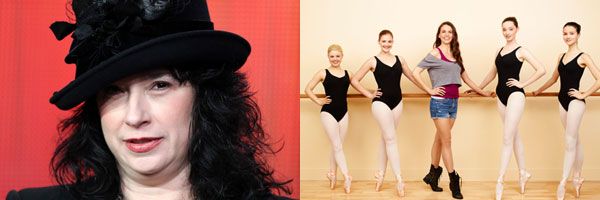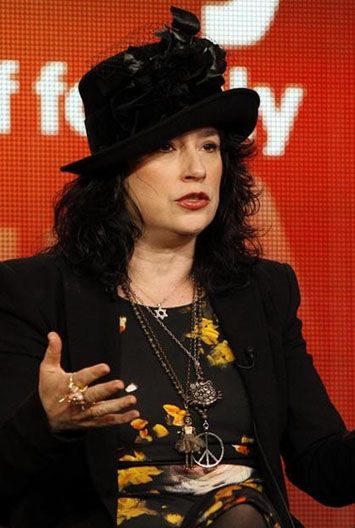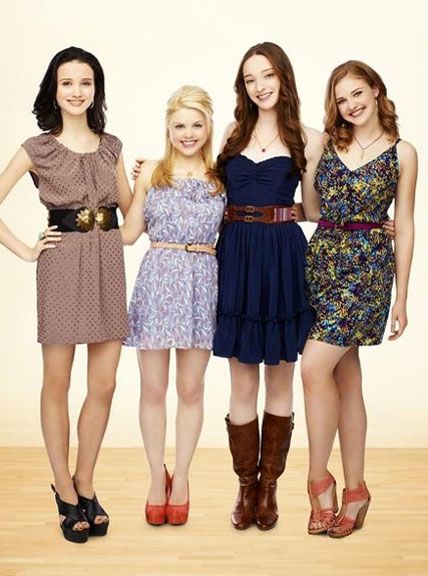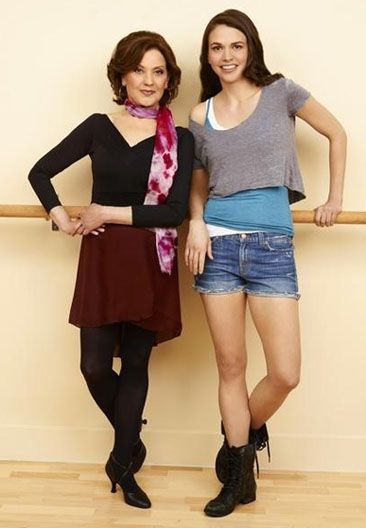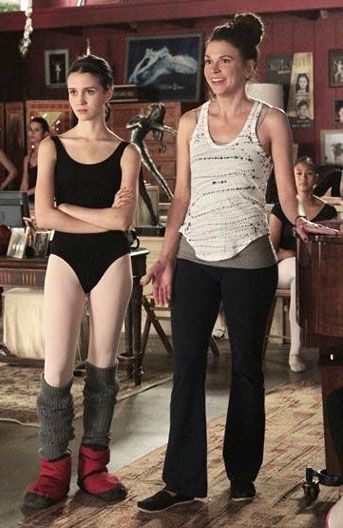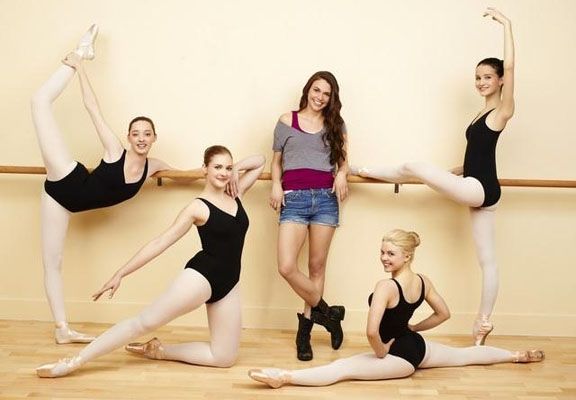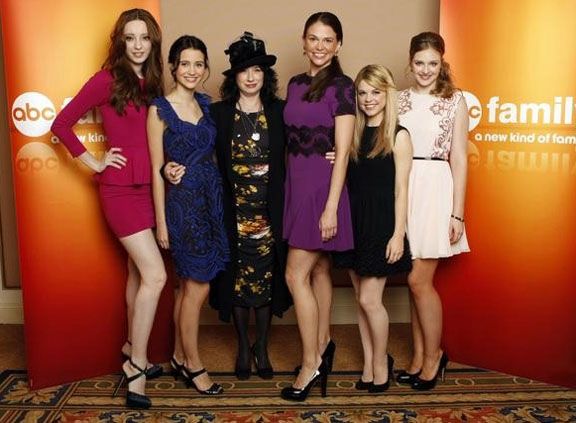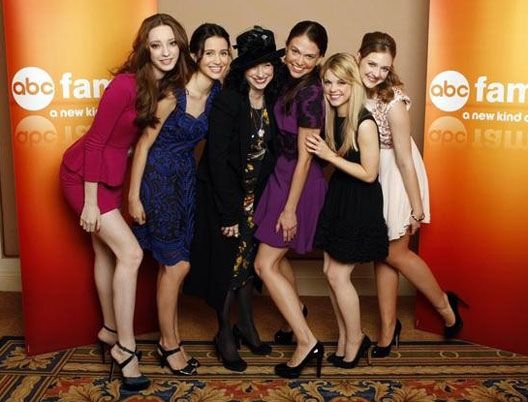On the ABC Family series Bunheads, Michelle Simms (played by Tony Award winner Sutton Foster) had a promising career as a classically–trained professional dancer, but was drawn to the lights of Las Vegas where things pretty much stalled out. After unexpectedly finding herself in the coastal town of Paradise, Calif., teaching at the local dance studio owned by Fanny Flowers (Kelly Bishop), she realizes that laying down roots might not be such a bad idea after all. The show also stars Kaitlyn Jenkins, Julia Goldani Telles, Bailey Buntain and Emma Dumont.
During this recent exclusive phone interview with Collider, show creator/executive producer/writer/director Amy Sherman-Palladino (Gilmore Girls) talked about how this show came about and came together, the challenges in finding the perfect actors to play very specific characters, that every show is an evolution, the logistics of shooting the dance numbers, especially when they have dialogue on top of the performance, what fans fan expect from the remaining episodes this season, always knowing her endgame, deciding which episodes she’ll direct, and that she’s written a couple of movies that she still hopes to get made someday. Check out what she had to say after the jump.
Collider: How did this show start for you? Did you want to do a show about dance and then shop it to networks, or did ABC Family come to you about doing something specifically for them?
AMY SHERMAN-PALLADINO: Dance was always part of my life because I was a dancer and my mother was a dancer, and I love the theater. This actually came about because Kate Juergens, the head of ABC Family, and I were looking for something to do together, at some point. She had been over at The WB when I did Gilmore Girls, so we already understood each other. And they were looking for something in an arena that would give them not necessarily musical stuff, but everybody was looking for their Glee, at one point, and I was like, “I don’t really want to do Glee because there is Glee. Glee is there.”
But, I’ve always been interested in the world of dance, and I was noodling around, doing notes for a play that was based on my ballet school. It had four little girls in class, and then four mothers on the other side of the glass. I co-opted that, and then threw it together with a central theme of what if you were supposed to be that dancer, and then you turn around, at some point, and it didn’t happen and probably is not going to happen, or you’re at the very tail end of it. What could that be? That could bring together the future and the present, and then Fanny would have that in her past, all connected through dance.
It wasn’t like I was looking to do dance numbers every week, but when I was in class, there was something so important about that dance studio and that dressing room. Your whole life happened there. Your fights happened there and your friends were there and your enemies were there. Everything happened in that little room. You grew up, you got fat, you got thin, you had your period, your feet bled, you were in pain and you all smelled bad. It’s such a weirdly intimate bonding background that I felt like that was a good visual area for stories.
And then, I picked four girls, none of whom may go on to be professional dancers, or maybe one or two of them will. Who knows? It’s not really about that. It’s really just about the experience of growing up, and the discipline and hard work. It just gave me a really interesting backdrop. That was the beginnings of it. It really just came from Kate and I sitting together, and her talking about her needs for the network.
The success of this show really seems to have relied on you finding the right cast, or it could have been a total disaster.
SHERMAN-PALLADINO: Absolutely, yes! Sutton Foster was the key.
Did you have to have that in place, before you could go any further with the show?
SHERMAN-PALLADINO: No, because I have a terrible habit of writing un-castable pilots. I am the queen of it. Literally, I think there’s a crown somewhere that says, “Nobody writes un-castable female parts like Amy Sherman-Palladino.” In my entire career, it’s usually come down to, “There was only one person to play Lorelai.” That is my thing. So, I wrote this pilot and I looked at the part of Michelle and I realized, “Once again, Amy, put the crown on. Now you’ve got to find this 35-year-old person who really had to be a legitimate dancer because you can’t fake that, and she has to be super funny, able to handle the dramatic scenes, and has to be somebody who nobody had really seen before.” It’s more fun to break somebody that the audience can go, “Oh, wow! Where the hell have you been, my whole life?”
It was a flooky timing thing where, right before I had started writing the pilot, I went to New York to see Anything Goes ‘cause I wanted to see all the shows that were going to be up for the Tonys, so that I could be legitimately outraged when my favorite didn’t win. If you don’t see them all, you can’t truly be outraged. I didn’t know Sutton. I had seen her in The Drowsy Chaperone, but I didn’t know her and I didn’t really know anything about her, other than what I saw in that one show. There was something about that particular performance in Anything Goes where I got on the phone with ABC Family, the next day, and said, “Do you guys know Sutton Foster?,” and they had heard of her, but didn’t really know anything about her. I said, “I could be completely high on crack, and I have nothing to base this on, but she might be our girl.”
I met with her for a, “Hi, how are you?,” and she had no make-up on. In the show, she was in this blonde wig and she was this glamorous showgirl. But, I sat with her at lunch and she had her hair in a ponytail, she looked like a 12-year-old, and she was eating chicken fingers. I was like, “Oh, so she’s a chameleon!” So, we sat and talked, and I went and wrote it, and then she came out here and we worked together a little while on it. There was never anyone else even in contention. From the minute I saw Anything Goes, it was a weird gut feeling that it was that girl. And I’ve gotta tell you, if we had not found Sutton, I don’t think Bunheads would have happened. That was it. She was the girl for the part.
And you’ve got a great cast around her, as well.
SHERMAN-PALLADINO: Yeah, it’s a great cast. It’s a delightful cast. They’re a fun cast to write for, and they’re a fun cast to hang out with. It’s a hard show. It’s 77 pages in seven days, and there’s a lot of yammer. You’ve gotta know your shit ‘cause there’s only a certain amount of time to do it. It’s a merry band of thieves. It’s our crazy little world and everybody is really just out for the good of the show. Nothing has set in yet. Nobody’s press agent has gotten to them yet and said, “Only pictures by themselves.” That hasn’t happened yet. It’s still a real gang feeling, and it starts with Sutton because she is the most incredible. Working with Sutton Foster makes you never want to work with anyone else, ever again, in your entire life. It just can’t get better!
Since it takes a show a little bit of time to find itself, once you had the actors in place and audiences got the chance to know the characters a little bit, did you feel like there was a point where it really hit its stride?
SHERMAN-PALLADINO: Every show is an evolution. The minute that you hit something hard that you felt like you pulled off, you’ve gotta push that bar up, a little bit more. It’s always a constant evolution. There was a lot to figure out with this show, like how you shoot it. No one at the studio or the network had ever done anything with this kind of dancing. Everybody does their own dancing, and there’s not a lot of real rehearsal time. We do everything right on the fly. So, we had to figure out how to do the ballet classes and do all the dialogue, with four young girls who really were very inexperienced. For Julia [Goldani Telles], who plays Sasha, this was the first acting thing she’d ever done. So, we had four real newbies and we had a pro with Sutton Foster on stage, but she’d never handled this sort of television role before.
The only person who was an old hat at this was Kelly Bishop. Everybody else was like, “Holy shit! How the hell do we do this?!” So, there were a lot of practical challenges to deal with, on top of letting these girls get used to hitting a mark without looking down at their feet, learning about eyelines, and coming in knowing all of their dialogue and the dancing, and putting it all together. And then, they needed parents and boyfriends, and they needed to fall in love.
There was just a lot to get in place, before we could even start to open their world up. The first 10 episodes was a lot of just getting our train going. Now with these eight episodes that we’re finishing up, it’s given us a lot more opportunity. The girls are more comfortable, they’ve got their sea legs under them, and they’re really becoming little pros, so we can throw more at them and make their lives even harder. That’s what I’m here for, to make everyone’s life even harder.
Was it really important to you to make sure you had different body types on this show, especially since this particular world of ballet is known for a very specific body type?
SHERMAN-PALLADINO: Yes, it was. It was scripted like that. Part of the problem with the casting process, and the reason that it really did come down to one person per role and there weren’t really choices, was that Sasha had to be a certain body type. She had to fit, physically, that ideal ballerina look with that kind of technique and that kind of ethereal air to her. And then, on top of that, the kid had to act. That was like, “Oh, Jesus Christ!” Finding the dancers who could act, or the actors who could dance was so hard. And then, Boo (Kaitlyn Jenkins) was the other really tricky part because I needed someone who had a rock star dance technique and was super strong, but who didn’t have the body. The problem there was that, a lot of times in the world of dance, when you don’t have the body, someone has told you to get out of dance a lot earlier. So, finding somebody who had stuck with it, who was that strong on pointe, and hadn’t stopped pointe to go to modern or something else, was really, really hard. And then, she also had to have that innocence and that positive, wide-eyed Bambi look at the world. There was a lot that went into it. Ginny (Bailey Buntain) was based on a girl that I went to ballet school with, so she was written short and busty because that’s something that knocks you out. And then, I needed a little comedian who was a little bombshell. It literally was that each person was a hard find. Your casting process for pilots is very short. It’s not like you have a year to go around and look for people and scour the ends of the earth, especially when you’re dealing with ABC Family, who has very structured seasons and a very short amount of time. It was very fortunate that we found the cast that we found, and they are perfect.
How difficult is it to execute these dance numbers, especially when they have dialogue on top of the performance?
SHERMAN-PALLADINO: It’s hard, but we have a choreographer named Marguerite Derricks, who literally is the other piece of the puzzle. It was so incredibly fortunate that we found her because she is unbelievable. She’s the kind of lady that I can call at night and be like, “I need a dance tomorrow! We’re five minutes short, so put them in black leotards and tights and smudge their make-up. I’ll send you a song.” And she comes up with these dances that are just fabulous. She works this girls in such an unbelievable manner. It’s the only way it would have happened. If I hadn’t have found her, I don’t think the dancing would be the prominent thing that it is now. It’s only that prominent because I have Marguerite. Without that other piece there, it would have been much more background than it is.
What can you say to tease fans of the show about what’s still coming up this season?
SHERMAN-PALLADINO: Well, you’re going to meet Michelle’s brother (played by Sutton Foster’s real-life brother, Hunter), which is going to give us a little bit more insight into her family. That’s our next little thing to open Michelle’s personal life up. We’re going to get the girls more deeply involved in romance and heartbreak, which we started in the first 10 and we’re going to keep going that way. You’ll meet a little bit more of their family. Sasha is going through a very big life change, which I’m really enjoying watching. And then, we get to have our beloved Liza Weil, from Gilmore Girls, who I’ve missed writing for. She’s on the show now, in a much more pronounced manner, and I’m very excited about that. It’s more of what we laid the seeds for. Now, we’re just going for it a little bit more. And there’s a lot more dancing.
Have you thought about exploring romantic relationships for Michelle, or does it feel like it’s still too soon to get into anything too serious for her?
SHERMAN-PALLADINO: We talk about it. With love relationships, you’ve gotta find the right actor before you can really commit to it. The one thing that we learned on Gilmore Girls was that, if you come up with the arc before you’ve got the person, nine out of 10 times, you’re rewriting a lot of story. All of my successful boys on Gilmore Girls, I found before I wrote the arc. Jared [Padalecki], Milo [Ventimiglia] and Matt Czuchry were all cast before I even created who their characters were. It was not so much that way with Jared, but I didn’t know how important Dean was going to be until we got Jared. So, we’re needing to do the same thing with Bunheads. I’m looking. But, Sutton Foster is really good, so the guy I throw up against her needs to be as good as she is. When you raise the bar that high, it’s tough. It’s gonna happen, but it’s gotta be the right person.
Because you have such a clear writing style, once you find an actor who does it well, does it tempt you to keep finding somewhere to stick them, with each project that you do?
SHERMAN-PALLADINO: Oh, absolutely! People are like, “Why do you have all these Gilmore Girls people on the show?,” and I’m like, “Because it took me years to find them!” Gilmore Girls was on for seven years, and it took me a long time to find those people. When you find people that are that good, that funny and can really deliver, they’re not on every block. There are not 500 Sean Gunns or Liza Weils out there. There’s one Kelly Bishop. That’s it. So, when you find these people, and they inspire jokes and speeches and stories, it’s very, very difficult to turn your back on that, and I don’t know why you would. TV is all about speed. TV is fast and furious. It’s gunslinger territory. So, when you know you have to deliver so much, so quickly, you’ve gotta go to the people that you know are going to deliver, immediately.
How much of the series do you have planned out, and how much are you open to seeing where the characters take you?
SHERMAN-PALLADINO: You always have to go into your block of episodes kind of knowing where you’re going, but things change and you have to be open to that. You cast someone who doesn’t work out, or you want to take someone down a particular road, but then you don’t like that. You can’t stick with it because, if it ain’t working, it ain’t working. So, it’s all a little fluid. However, we always go into out block of episodes knowing where it’s going to end because it would be lunacy to not have your endgame. You have to know what you’re writing toward. When we sent Sasha down the road that we’ve set her down, with the trouble with her parents and her parents splitting up, we needed to know what we were going to do with that. Our time is very limited. We get very little pre-production, and once production starts, we are flying. There’s no chance to catch your breath. So, if you don’t know what your road map is, you’re just gonna die. You’re going to be in a corner, crying and eating your hair. You’ve gotta have a path. And then, within that path, you have to be flexible. When things aren’t working, you’ve gotta cut bait and find something else, but if you don’t have a path, you’re just dead.
How do you decide which episodes you’ll direct?
SHERMAN-PALLADINO: I always direct the first and last episodes. That’s what I did on Gilmore Girls, and that’s what I do on Bunheads. It’s important that I set the tone for whatever it is, and I always want to wrap it up, at the end. Because we only did eight episodes in this block, I only directed two. When we did the season of Gilmore Girls where we were going to have the 100th episode, I was like, “I’m directing that!” So, it’s good to be queen. It’s nice to be able to sit there and go, “That’s a story I feel very strongly about.” For our season finale, we’re doing something that harkens back to my youthfulness when I was auditioning, as a dancer. I just felt like, “I need to be the one to direct this because it’s literally something that I went through.” So, there are moments like that, even more so with the scripts that I write. Even though everything is really rewritten by me and Dan [Palladino], and everything has got my pass on it, there’s always going to be certain things where you’re like, “That’s mine! I’ve gotta shout it to the world that that’s mine!”
What do you enjoy about collaborating directly with the actors on set, when you’re directing an episode?
SHERMAN-PALLADINO: It’s very more fun directing than writing. Writing is a sad process, sitting on your ass for many, many hours, alone in a room, smelling like coffee, sadness and bitterness, and watching your youth leave. Writing is very hard. With directing, you have to wake up early, which stinks, but you get to hang out with the crew, you’re laughing, you’re active, and you’re working with the actors. It’s just more fun. It’s being part of humanity, at least for a few days. It’s good to do both. Directing is very tiring. You’re making 35 million decisions a day that are snap judgements and it’s very stressful, but it’s really fun. I would recommend that any writer get off their ass at least once and just try it. Directing is a completely different set of muscles. It also affects your writing because, once you start directing, you tend to write your scripts with directing in mind, which I think actually helps when you have other directors who come in. The way television works is that directors come in and out, and they’re not there all the time, following every character through every scene. They’re vagabonds who go from one show to another. So, it helps, if you’ve directed, to be able to write a script that is director-friendly. You’re really telling them, “This is how it works on this show.” It takes some of the guesswork out of it.
Do you have any projects tucked away somewhere, that you’re hoping to have the chance to make someday?
SHERMAN-PALLADINO: Yes, I’ve got a couple of movies that I’m still trying to get going. It’s tough to get any film made, even if you’re Martin Scorsese. It’s just hard to get films made. Now, more and more, the only films they’re making are giant 3D blockbuster films. With the stuff that I like to write, it would have been easier for me to get a film going in the ‘80s, during the Jim Brooks years. That being said, nobody said it was supposed to be easy. This business isn’t easy. It’s a hard business. You just keep plugging away until you figure it out. You write something you love and keep banging on people’s heads until somebody lets you do it.
Bunheads airs on Monday nights on ABC Family.

